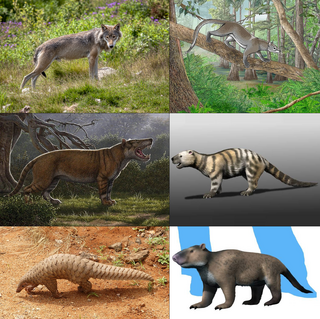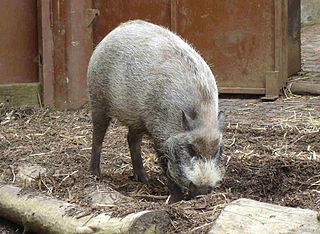Order is one of the eight major hierarchical taxonomic ranks in Linnaean taxonomy. It is classified between family and class. In biological classification, the order is a taxonomic rank used in the classification of organisms and recognized by the nomenclature codes. An immediately higher rank, superorder, is sometimes added directly above order, with suborder directly beneath order. An order can also be defined as a group of related families.

Placental mammals are one of the three extant subdivisions of the class Mammalia, the other two being Monotremata and Marsupialia. Placentalia contains the vast majority of extant mammals, which are partly distinguished from monotremes and marsupials in that the fetus is carried in the uterus of its mother to a relatively late stage of development. The name is something of a misnomer considering that marsupials also nourish their fetuses via a placenta, though for a relatively briefer period, giving birth to less developed young which are then nurtured for a period inside the mother's pouch.

Taeniolabidoidea is a group of extinct mammals known from North America and Asia. They were the largest members of the extinct order Multituberculata, as well as the largest non-therian mammals. Lambdopsalis even provides direct fossil evidence of mammalian fur in a fairly good state of preservation for a 60-million-year-old animal. Some of these animals were large for their time; Taeniolabis taoensis is the largest known multituberculate and though smaller, Yubaatar is the largest known Mesozoic Asian multituberculate. Average members of the Taeniolaboidea were about beaver-sized and the largest even reached sizes comparable to the largest beavers like Castoroides, up to about 100 kilograms.
Mimetodon is a small mammal from the Paleocene of North America and perhaps Europe. It was a member of the extinct order Multituberculata within the suborder Cimolodonta and family Neoplagiaulacidae.

Mammalia is a class of animal within the phylum Chordata. Mammal classification has been through several iterations since Carl Linnaeus initially defined the class. No classification system is universally accepted; McKenna & Bell (1997) and Wilson & Reader (2005) provide useful recent compendiums. Many earlier ideas from Linnaeus et al. have been completely abandoned by modern taxonomists, among these are the idea that bats are related to birds or that humans represent a group outside of other living things. Competing ideas about the relationships of mammal orders do persist and are currently in development. Most significantly in recent years, cladistic thinking has led to an effort to ensure that all taxonomic designations represent monophyletic groups. The field has also seen a recent surge in interest and modification due to the results of molecular phylogenetics.

Simplicidentata is a group of mammals that includes the rodents and their closest extinct relatives. The term has historically been used as an alternative to Rodentia, contrasting the rodents with their close relatives the lagomorphs. However, Simplicidentata is now defined as including all members of Glires that share a more recent common ancestor with living rodents than with living lagomorphs. Thus, Simplicidentata is a total group that is more inclusive than Rodentia, a crown group that includes all living rodents, their last common ancestor, and all its descendants. Under this definition, the loss of the second pair of upper incisors is a synapomorphic feature of Simplicidentata. The loss of the second upper premolar (P2) has also been considered as synapomorphic for Simplicidentata, but the primitive simplicidentate Sinomylus does have a P2.

Ferae is a mirorder of placental mammals that groups together clades Pan-Carnivora and Pholidotamorpha. The Ferae is a sister group to the clade Pan-Euungulata and together they make grandorder Ferungulata.

Ferungulata is a grandorder of placental mammals that groups together mirorder Ferae and clade Pan-Euungulata. It has existed in two guises, a traditional one based on morphological analysis and a revised one taking into account more recent molecular analyses. The Fereungulata is a sister group to the order Chiroptera (bats) and together they make clade Scrotifera.
Eurymylidae is a family of extinct simplicidentates. Most authorities consider them to be basal to all modern rodents and may have been the ancestral stock whence the most recent common ancestor of all modern rodents arose. However, the more completely known eurymylids, including Eurymylus, Heomys, Matutinia, and Rhombomylus, appear to represent a monophyletic side branch not directly ancestral to rodents. Huang et al. (2004) have argued that Hanomys, Matutinia, and Rhombomylus form a clade characterized by distinctive features of the skull and dentition that should be recognized as a separate family, Rhombomylidae. Eurymylids are only known from Asia.
The legion, in biological classification, is a non-obligatory taxonomic rank within the Linnaean hierarchy sometimes used in zoology.

Suinae is a subfamily of artiodactyl mammals that includes several of the extant members of Suidae and their closest relatives – the domestic pig and related species, such as babirusas. Several extinct species within the Suidae are classified in subfamilies other than Suinae. However, the classification of the extinct members of the Suoidea – the larger group that includes the Suidae, the peccary family (Tayassuidae), and related extinct species – is controversial, and different classifications vary in the number of subfamilies within Suidae and their contents. Some classifications, such as the one proposed by paleontologist Jan van der Made in 2010, even exclude from Suinae some extant taxa of Suidae, placing these excluded taxa in other subfamilies.

In biology, taxonomic rank is the relative level of a group of organisms in an ancestral or hereditary hierarchy. A common system of biological classification (taxonomy) consists of species, genus, family, order, class, phylum, kingdom, domain. While older approaches to taxonomic classification were phenomenological, forming groups on the basis of similarities in appearance, organic structure and behaviour, methods based on genetic analysis have opened the road to cladistics.
Henricosborniidae is a family of extinct notoungulate mammals known from the Late Paleocene to Middle Eocene of Argentina, Bolivia and Brazil. The name honors U.S. paleontologist Henry Fairfield Osborn.

Campanorco is an extinct genus of notoungulate mammal from the Middle Eocene Lumbrera Formation, Argentina, South America and the only member of the family Campanorcidae.

Notioprogonia is a suborder of the extinct mammalian order Notoungulata and includes two families, Henricosborniidae and Notostylopidae.

Typotheria is a suborder of the extinct mammalian order Notoungulata and includes five families: Archaeopithecidae, Campanorcidae, Interatheriidae, Mesotheriidae, and Oldfieldthomasiidae. Cifelli indicated that Typotheria would be paraphyletic if it excluded members of the suborder Hegetotheria and he advocated inclusion of the hegetothere families Archaeohyracidae and Hegetotheriidae in Typotheria.

Nesodon is a genus of Miocene mammal belonging to the extinct order Notoungulata which inhabited southern South America during the Late Oligocene to Miocene living from 29.0 to 16.3 Ma and existed for approximately 12.7 million years. It had a relatively large size, weighing up to 554 kg (1221 lbs) and reaching 1.5 m in height.

Altungulata or Pantomesaxonia is an invalid clade (mirorder) of ungulate mammals comprising the perissodactyls, hyracoids, and tethytheres.

Pan-Euungulata is a clade of placental mammals from grandorder Ferungulata, consisting of the mirorder Euungulata and extinct family Protungulatidae.














